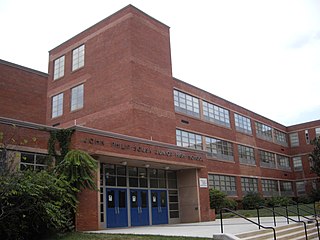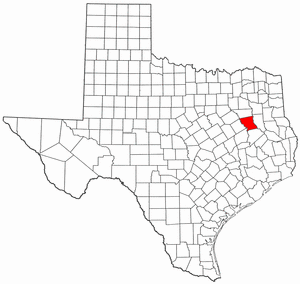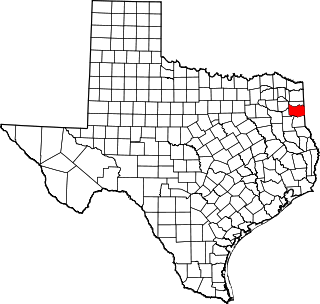
Presidio County is a county located in the U.S. state of Texas. As of the 2020 census, its population was 6,131. Its county seat is Marfa. The county was created in 1850 and later organized in 1875. Presidio County is in the Trans-Pecos region of West Texas and is named for the border settlement of Presidio del Norte. It is on the Rio Grande, which forms the Mexican border.

Marfa is a city in the high desert of the Trans-Pecos in far West Texas, United States, between the Davis Mountains and Big Bend National Park, at an elevation of 4685 feet. It is the county seat of Presidio County.The city was founded in the early 1880s as a water stop. The population of Marfa peaked in the 1930s and as of the 2020 United States Census the population is 1,788.

A National Historic Landmark (NHL) is a building, district, object, site, or structure that is officially recognized by the United States government for its outstanding historical significance. Only some 2,500, or roughly three percent, of over 90,000 places listed on the country's National Register of Historic Places are recognized as National Historic Landmarks.
Brown v. Board of Education National Historical Park was established in Topeka, Kansas, on October 26, 1992, by the United States Congress to commemorate the landmark decision of the U.S. Supreme Court in the case Brown v. Board of Education aimed at ending racial segregation in public schools. On May 17, 1954, the Supreme Court unanimously declared that "separate educational facilities are inherently unequal" and, as such, violated the Fourteenth Amendment to the United States Constitution, which guarantees all citizens "equal protection of the laws."

In the United States, a National Heritage Area (NHA) is a site designated by Act of Congress, intended to encourage historic preservation of the area and an appreciation of the history and heritage of the site. There are currently 62 NHAs, some of which use variations of the title, such as National Heritage Corridor.

The Amache National Historic Site, formally the Granada War Relocation Center but known to the internees as Camp Amache, was a concentration camp for Japanese Americans in Prowers County, Colorado. Following the Japanese attack on Pearl Harbor on December 7, 1941, Japanese Americans on the West Coast were rounded up and sent to remote camps. Among the inmates, the notation "亜町" was sometimes applied.

The New Philadelphia National Historic Site is the original site of the now-vanished town of New Philadelphia, Illinois, in the United States. It is located near the western Illinois city of Barry, in Pike County.

Sylvia Mendez is an American civil rights activist and retired nurse. At age eight, she played an instrumental role in the Mendez v. Westminster case, the landmark desegregation case of 1946. The case successfully ended de jure segregation in California and paved the way for integration and the American civil rights movement.

The John Philip Sousa Middle School, formerly the John Philip Sousa Junior High School, is a public school located at 3650 Ely Place in SE area of Washington, D.C. Located in the city's Fort Dupont neighborhood, it serves grades 6–8. Its school building, built in 1950, was the scene of civil rights action not long after its construction. Twelve black students were denied admission to the all-white school. This action was eventually overturned in the landmark 1954 Supreme Court decision in Bolling v. Sharpe, which made segregated public schools illegal in the District of Columbia. The defeat of the legal doctrine "separate but equal" marked an early victory in the modern Civil Rights Movement.

This is a list of the National Register of Historic Places listings in Bexar County, Texas.

This is intended to be a complete list of properties and districts listed on the National Register of Historic Places in Galveston County, Texas. There are 10 districts, 73 individual properties, and four former properties listed on the National Register in the county. Two districts and one individually listed property are National Historic Landmarks. One district and six individually listed properties are State Antiquities Landmarks. Seventy-two properties are Recorded Texas Historic Landmarks including one property that contains two while four districts contain many more.

This is a list of the National Register of Historic Places listings in Victoria County, Texas.

This is a list of the National Register of Historic Places listings in Tarrant County, Texas.

This is a list of the National Register of Historic Places listings in Anderson County, Texas.

This is a list of the National Register of Historic Places listings in Gillespie County, Texas.

This is a list of the National Register of Historic Places listings in Harrison County, Texas.

This is a list of the National Register of Historic Places listings in El Paso County, Texas.

Phoenix Union High School (PUHS) was a high school that was part of the Phoenix Union High School District in downtown Phoenix, Arizona, one of five high school-only school districts in the Phoenix area. Founded in 1895 and closed in 1992, the school consisted of numerous buildings on a campus which by 1928 consisted of 18 acres.

In the United States, school integration is the process of ending race-based segregation within American public and private schools. Racial segregation in schools existed throughout most of American history and remains an issue in contemporary education. During the Civil Rights Movement school integration became a priority, but since then de facto segregation has again become prevalent.

The history of African Americans in Austin dates back to 1839, when the first African American, Mahala Murchison, arrived. By the 1860s, several communities were established by freedmen that later became incorporated into the city proper. The relative share of Austin's African-American population has steadily declined since its peak in the late 20th century.





















